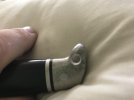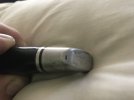eveled
Basic Member
- Joined
- Mar 11, 2016
- Messages
- 8,138
i have an experimental 121. I call it that because I experiment with it. It came to me for cheap money because it has a major chip in the blade.
First step was to use a small file to turn the jagged chip into a smooth sharp Seration. This hopefully removes any starting point for a crack and by sharpening it, it no longer catches material when slicing.
This was a couple of years ago and still not broken. I just sharpen over it and it is shrinking as the blade wears.
Second thing I have always wondered. Can phenolic handled knives survive the dishwasher? I turns out yes they can. But the pommel gets oxidized rough and discolored.
Third. I never liked the bump on the pommel. File in hand I attacked it. Big mistake 10 strokes later I had busted through into a hollow spot.

So don’t do this!
Fourth. I have always wondered if I could add a lanyard hole with basic tools. This came out amazingly well. I think.

Hope this stuff helps others.
First step was to use a small file to turn the jagged chip into a smooth sharp Seration. This hopefully removes any starting point for a crack and by sharpening it, it no longer catches material when slicing.
This was a couple of years ago and still not broken. I just sharpen over it and it is shrinking as the blade wears.
Second thing I have always wondered. Can phenolic handled knives survive the dishwasher? I turns out yes they can. But the pommel gets oxidized rough and discolored.
Third. I never liked the bump on the pommel. File in hand I attacked it. Big mistake 10 strokes later I had busted through into a hollow spot.
So don’t do this!
Fourth. I have always wondered if I could add a lanyard hole with basic tools. This came out amazingly well. I think.
Hope this stuff helps others.
Last edited:


